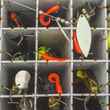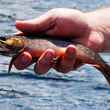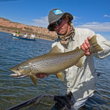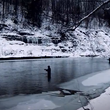Autumn offers a series of distinct challenges to the angler that are specific to the season. Streams and rivers are typically lower and clearer than they are throughout most of the summer. Hatches have tapered off. Leaves blanket the water. Water temperatures change. Sun angles shift. All of these differences and more add up to the angler being faced with a different puzzle, one that requires a change in approach in order to have continued success.
Though there are certainly more ways than what follows via which the fly fisherman can adapt to changing autumn conditions, here are five helpful tips to increase your chances of a good day on the water.
Mind the Sun
The autumn sun is lower in the sky throughout the day when compared to summer. The result is lower sun angles through most of the day, which means longer shadows. This requires the angler to use a stealthier approach, as the ability for your shadow to spook fish is increased. Pay attention to the sun's position relative to yours, which way your shadow is being cast and how far. You can't catch fish that you've chased off with a lazy, unthoughtful approach.
Mind Your Clothing
The sun isn't the only reason it is easier to spook fish in the autumn. Low and clear water conditions not only make it easier for the trout to see things above the water's surface, they also make them more wary. Clothing is always an important factor in remaining stealthy as an angler, but its importance is paramount in the fall. Wear autumnal colors, or even better, camouflage.
Pay Attention to Water Temperature
Anglers are often accustomed to thinking that early morning and late evening are the best times to catch trout, and by in large, this is true. In many areas of the country, fishermen may even avoid the daytime hours when sun blankets the water, water temperatures rise and trout seek thermal refuge. In the autumn, however, cooling water temps typically result in conditions that make the entire day an opportunity to take feeding fish. As temperatures chill even further, water temperatures can result in trout that are lethargic during the early morning and late evening hours, instead feeding most actively in the sun-warmed water of mid-day. Take note of the temperatures of the stream or river you're headed to fish, and adjust your approach accordingly.
Understand the Trout's Changing Behavior
Brook and Brown trout, both species which spawn in very late summer and/or autumn, are much more agitated and aggressive in the fall. This is a result of behavioral changes related to spawning that create increased territoriality. This is one of the reasons why autumn is a great time to fish with streamers. Aggressive, territorial trout are more likely to chase and hopefully take streamers and other flies that may represent a threat or disturbance to a trout preparing to spawn. Think about fly size, profile and color with the aim of irritating an already cranky fish.
Eggs, Anyone?
As noted above, fall means spawning and spawning means eggs. Egg patterns -- or god forbid, beads -- it should come as no surprise, are increasingly effective in water where eggs from spawning fish are floating around. Browns and Brook trout will both eat eggs that are produced by their brethren, and where rainbow trout and these other species share waterways, rainbows can feed aggressively on eggs. Whether you find the use of egg patterns sporting is for you to decide, but the fact is they take fish and can often be the cure for an otherwise slow day.
We'd love to hear from you as well. Please share your favorite tips for fall fishing in the comments below.

































Comments
DDon replied on Permalink
Orange. That's my tip.
Orange streamers kill for me in the fall.
spiller replied on Permalink
Stay away from fish that are already on redds!
This isn't going to help you catch fish this year, but giving those fish a chance to spawn will help you catch fish in years to come.
MrFloCO replied on Permalink
Instead of telling people to not do something, we should educate. If you know what it means when trout are on a redd then you probably know not to fish to them or cross the stream where there are redds.
A redd is a spawning nest. You can usually see a lighter area in the rocks on the stream bed. Walking on a redd can ruin it, so beware. Often you'll see trout with extraordinary bright colors. They're spawning and you do not want to interrupt them. You wouldn't step on a birds nest with eggs in it, would you?
Scott Z replied on Permalink
Good call Paul. All too often I see and hear other anglers complaining and getting angry when it comes to redds. I agree with you, they are super difficult and hard to recognize. So instead of getting mad, let’s educate. Because 9/10 anglers who are able to recognize them won’t bother them. The other 1/10 are just a***holes.
Paul Hughes replied on Permalink
Good points
Pages